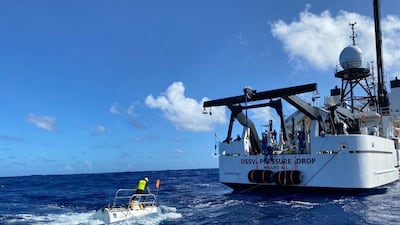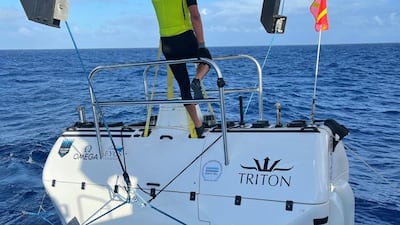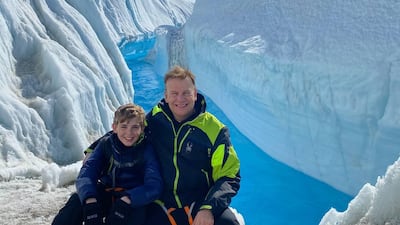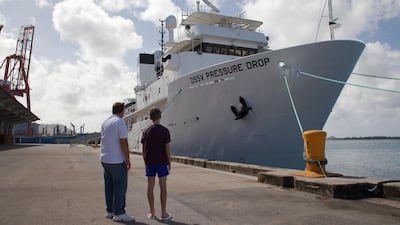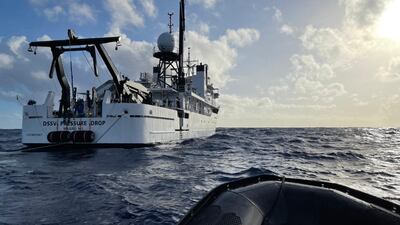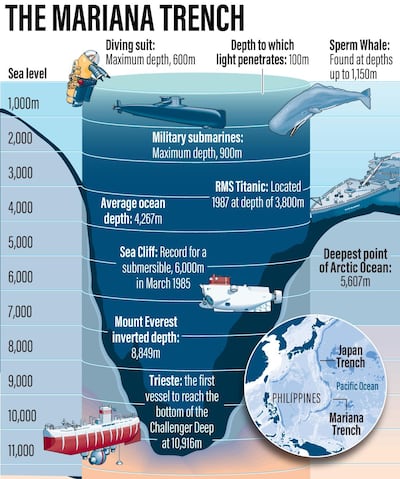A Dubai resident made a successful – and potentially record-breaking – journey to the bottom of the ocean on Friday.
British national Hamish Harding, 49, descended nearly 11 kilometres to the deepest place on Earth – the Challenger Deep in the Mariana Trench.
Only 18 people have previously made it to the depths of the Pacific floor – which is equivalent in height to a stack of 13 Burj Khalifas.
Mr Harding spent more than 12 hours below the ocean's surface in a small submersible, before re-emerging to the cheers of his team on a nearby expedition yacht.
As part of the mission, he aimed to break a world record by scouring the sea floor for up to four hours. Confirmation of the attempt will be announced by the Guinness World Records next week.
Mr Harding, a business jet salesman in the UAE, was joined on the trip by his 13-year-old son, Giles , who attends Dubai College.
Giles documented his father’s every move on Instagram while on board the expedition yacht.
"My father's world record-breaking descent into the Mariana Trench's deepest point, #TheChallengerDeep, has begun," he posted, early on Friday morning.
"Captain Hamish Harding's venture will take over twelve hours to complete, and as of now, he is 2% of the way through his mission.
"Hold your breath and see you on the other side with #OneMoreRecord!"
At noon UAE time on Friday, Giles said his father had completed the "traversal across the Challenger Deep" and started his ascent to the surface.
And by 3.35pm, Mr Harding breathed a sigh of relief as he successfully peered out from above the water's surface after the challenging feat.
"Congratulations to Captain Hamish Harding @actionaviationchairman on completing his expedition to the world's lowest point, the #Challengedeep and becoming the first human to traverse the entire Challenger Deep," he said.
"We couldn't be more excited to hear your thoughts about the journey, Captain! More information awaits as the Deep Submersible vessel is recovered."
During Mr Harding’s deep dive, he surpassed the maximum diving depths of mammals, at 2,500m, then plunged passed the 9,000m mark, the usual cruising height of a commercial airliner.
He was joined on the purpose-built Triton submersible, DSV Limiting Factor, by American explorer, Victor Vescovo.
Mr Vescovo himself currently holds the world record for the deepest dive by a crewed vessel.
The two-man submersible was designed to take 100,000 tonnes of pressure at full ocean depth; 1,200 times more than the standard atmospheric pressure at sea level.
Speaking to The National before his descent, Mr Harding said he hoped to explore for new marine species and search for evidence of whether human pollution had reached the ocean floor.
“The Challenger Deep is a little-studied and incredibly hostile environment. During the dive, we will attempt, using a robotic arm, to collect samples from the ocean floor that could contain new forms of life," said Mr Harding.
“And, in searching for signs of human pollution in this remote environment, we hope to aid scientific efforts to protect our oceans and ensure they flourish for millennia to come."
Humans first conquered the Challenger Deep in 1960, seven years after reaching the highest point on Earth, Mount Everest.
